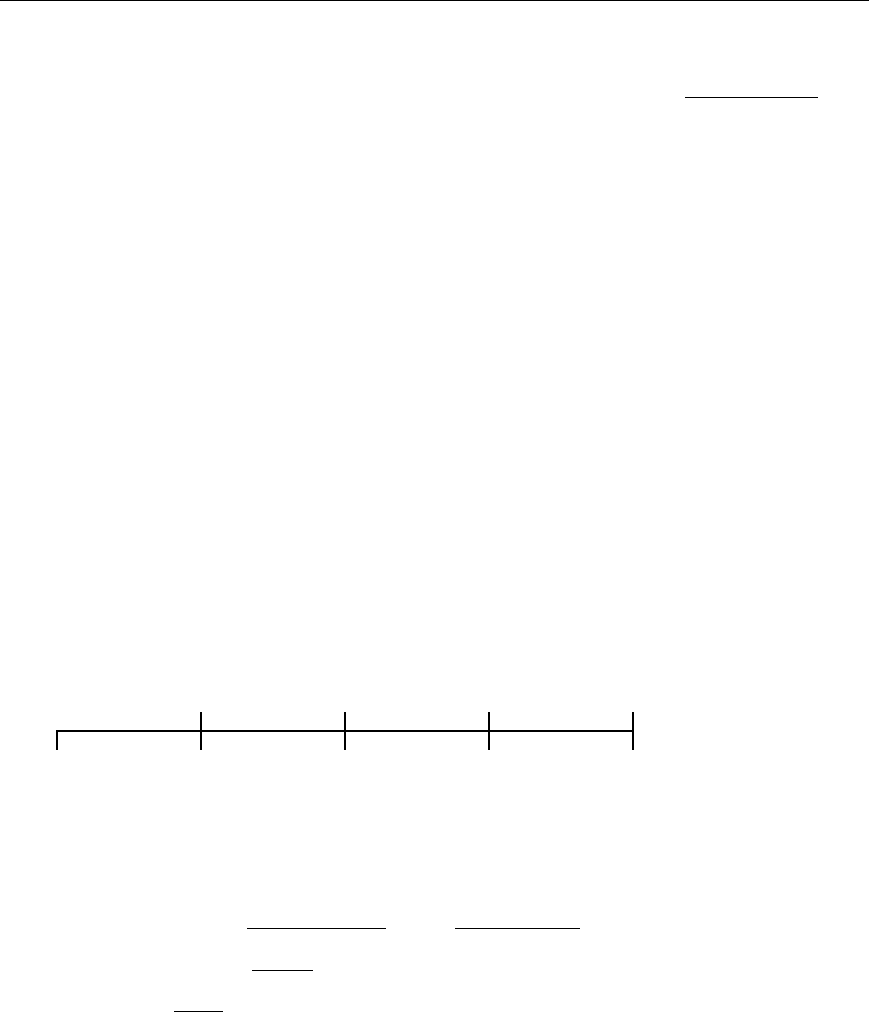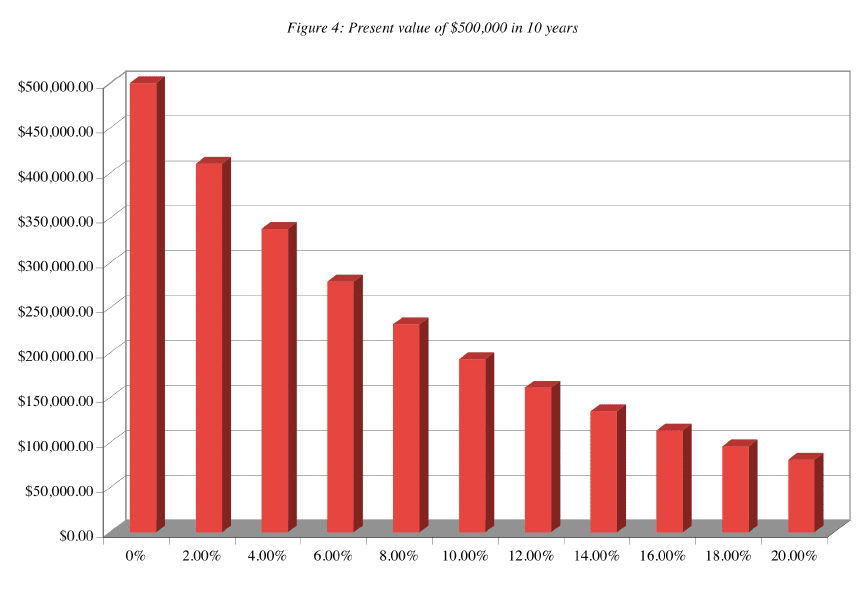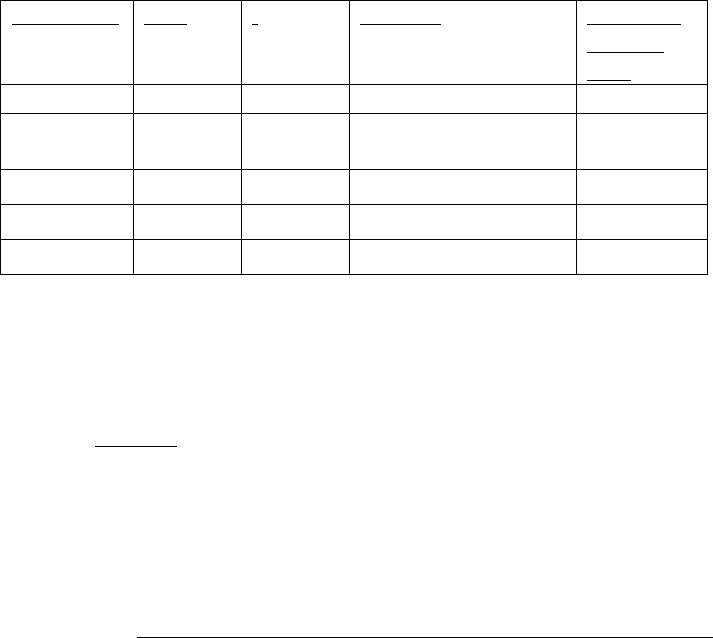Damodaran A. Applied corporate finance
Подождите немного. Документ загружается.


1
1
APPENDIX 3
TIME VALUE OF MONEY
The simplest tools in finance are often the most powerful. Present value is a
concept that is intuitively appealing, simple to compute, and has a wide range of
applications. It is useful in decision making ranging from simple personal decisions -
buying a house, saving for a child's education and estimating income in retirement, –– to
more complex corporate financial decisions - picking projects in which to invest as well
as the right financing mix for these projects.
Time Lines and Notation
Dealing with cash flows that are at different points in time is made easier using a
time line that shows both the timing and the amount of each cash flow in a stream. Thus,
a cash flow stream of $100 at the end of each of the next 4 years can be depicted on a
time line like the one depicted in Figure 1.
0
1
2
3
4
$ 100
$ 100
$ 100
$ 100
Figure 1: A Time Line for Cash Flows: $ 100 in Cash Flows Received at
the End of Each of Next 4 years
Cash Flows
Year
In the figure, 0 refers to right now. A cash flow that occurs at time 0 is therefore already
in present value terms and does not need to be adjusted for time value. A distinction must
be made here between a period of time and a point in time. The portion of the time line
between 0 and 1 refers to period 1, which, in this example, is the first year. The cash flow
that occurs at the point in time “1” refers to the cash flow that occurs at the end of period
1. Finally, the discount rate, which is 10% in this example, is specified for each period on
the time line and may be different for each period. Had the cash flows been at the
beginning of each year instead of at the end of each year, the time line would have been
redrawn as it appears in Figure 2.

2
2
0
1
2
3
4
$ 100
$ 100
$ 100
$ 100
Figure 2: A Time Line for Cash Flows: $ 100 in Cash Received at the Beginning
of Each Year for Next 4 years
Cash Flow
Year
Note that in present value terms, a cash flow that occurs at the beginning of year 2 is the
equivalent of a cash flow that occurs at the end of year 1.
Cash flows can be either positive or negative; positive cash flows are called cash
inflows and negative cash flows are called cash outflows. For notational purposes, we
will assume the following for the chapter that follows:
Notation Stands for
PV Present Value
FV Future Value
Cf
t
Cash flow at the end of period t
A Annuity – Constant cash flows over several periods
r Discount rate
g Expected growth rate in cash flows
n Number of years over which cash flows are received or paid
The Intuitive Basis for Present Value
There are three reasons why a cash flow in the future is worth less than a similar
cash flow today.
(1) Individuals prefer present consumption to future consumption. People would have to
be offered more in the future to give up present consumption. If the preference for
current consumption is strong, individuals will have to be offered much more in terms
of future consumption to give up current consumption, a trade-off that is captured by a
high “real” rate of return or discount rate. Conversely, when the preference for current
consumption is weaker, individuals will settle for much less in terms of future
consumption and, by extension, a low real rate of return or discount rate.

3
3
(2) When there is monetary inflation, the value of currency decreases over time. The
greater the inflation, the greater the difference in value between a cash flow today and
the same cash flow in the future.
(3) A promised cash flow might not be delivered for a number of reasons: the promisor
might default on the payment, the promisee might not be around to receive payment; or
some other contingency might intervene to prevent the promised payment or to reduce
it.. Any uncertainty (risk) associated with the cash flow in the future reduces the value
of the cashflow.
The process by which future cash flows are adjusted to reflect these factors is called
discounting, and the magnitude of these factors is reflected in the discount rate. The
discount rate incorporates all of the above mentioned factors. In fact, the discount rate
can be viewed as a composite of the expected real return (reflecting consumption
preferences in the aggregate over the investing population), the expected inflation rate (to
capture the deterioration in the purchasing power of the cash flow) and the uncertainty
associated with the cash flow. Models to measure this uncertainty and capture it in the
discount rate are examined in Chapters 6 and 7.
The Mechanics of Time Value
The process of discounting future cash flows converts them into cash flows in
present value terms. Conversely, the process of compounding converts present cash flows
into future cash flows.
There are five types of cash flows - simple cash flows, annuities, growing
annuities, perpetuities and growing perpetuities –– which we discuss below.
Simple Cash Flows
A simple cash flow is a single cash flow in a specified future time period; it can
be depicted on a time line in figure 3:
0
8
Cash inflow: CF
t
Figure 3: Present Value of a Cash Flow
1
2
3
4
5
6
7
Year
Discounting converts future casfflow into cash flow today

4
4
where CF
t
= the cash flow at time t.
This cash flow can be discounted back to the present using a discount rate that reflects the
uncertainty of the cash flow. Concurrently, cash flows in the present can be compounded
to arrive at an expected future cash flow.
I. Discounting a Simple Cash Flow
Discounting a cash flow converts it into present value dollars and enables the user
to do several things. First, once cash flows are converted into present value dollars, they
can be aggregated and compared. Second, if present values are estimated correctly, the
user should be indifferent between the future cash flow and the present value of that cash
flow. The present value of a cash flow can be written as follows
Present Value of Simple Cash Flow =
!
CF
t
(1+ r)
t
where
CF
t
= Cash Flow at the end of time period t
r = Discount Rate
Other things remaining equal, the present value of a cash flow will decrease as the
discount rate increases and continue to decrease the further into the future the cash flow
occurs.
To illustrate this concept, assume that you own are currently leasing your office
space, and expect to make a lump sum payment to the owner of the real estate of
$500,000 ten years from now. Assume that an appropriate discount rate for this cash flow
is 10%. The present value of this cash flow can then be estimated –
Present Value of Payment =
!
$500,000
(1.10)
10
= $192,772
This present value is a decreasing function of the discount rate, as illustrated in Figure 4.

5
5
II. Compounding a Cash Flow
Current cash flows can be moved to the future by compounding the cash flow at
the appropriate discount rate.
Future Value of Simple Cash Flow = CF
0
(1+ r)
t
where
CF
0
= Cash Flow now
r = Discount rate
Again, the compounding effect increases with both the discount rate and the
compounding period.
As the length of the holding period is extended, small differences in discount rates
can lead to large differences in future value. In a study of returns on stocks and bonds
between 1926 and 1997, Ibbotson and Sinquefield found that stocks on the average made
12.4%, treasury bonds made 5.2%, and treasury bills made 3.6%. Assuming that these
returns continue into the future, Table 1 provides the future values of $ 100 invested in
each category at the end of a number of holding periods - 1 year, 5 years, 10 years, 20
years, 30 years, and 40 years.

6
6
Table 1: Future Values of Investments - Asset Classes
Holding Period
Stocks
T. Bonds
T.Bills
1
$112.40
$105.20
$103.60
5
$179.40
$128.85
$119.34
10
$321.86
$166.02
$142.43
20
$1,035.92
$275.62
$202.86
30
$3,334.18
$457.59
$288.93
40
$10,731.30
$759.68
$411.52
The differences in future value from investing at these different rates of return are small
for short compounding periods (such as 1 year) but become larger as the compounding
period is extended. For instance, with a 40-year time horizon, the future value of
investing in stocks, at an average return of 12.4%, is more than 12 times larger than the
future value of investing in treasury bonds at an average return of 5.2% and more than 25
times the future value of investing in treasury bills at an average return of 3.6%.
III. The Frequency of Discounting and Compounding
The frequency of compounding affects both the future and present values of cash
flows. In the examples above, the cash flows were assumed to be discounted and
compounded annually –– i.e., interest payments and income were computed at the end of
each year, based on the balance at the beginning of the year. In some cases, however, the
interest may be computed more frequently, such as on a monthly or semi-annual basis. In
these cases, the present and future values may be very different from those computed on
an annual basis; the stated interest rate, on an annual basis, can deviate significantly from
the effective or true interest rate. The effective interest rate can be computed as follows
Effective Interest Rate =
!
1 +
Stated Annual Interest Rate
n
"
#
$
%
&
'
n
(1
where
n = number of compounding periods during the year (2=semiannual; 12=monthly)
For instance, a 10% annual interest rate, if there is semiannual compounding, works out
to an effective interest rate of
Effective Interest Rate = 1.05
2
- 1 = .10125 or 10.25%

7
7
As compounding becomes continuous, the effective interest rate can be computed as
follows
Effective Interest Rate = exp
r
- 1
where
exp = exponential function
r = stated annual interest rate
Table 2 provides the effective rates as a function of the compounding frequency.
Table 2: Effect of Compounding Frequency on Effective Interest Rates
Frequency
Rate
t
Formula
Effective
Annual
Rate
Annual
10%
1
.10
10%
Semi-
Annual
10%
2
(1+.10/2)
2
-1
10.25%
Monthly
10%
12
(1+.10/12)
12
-1
10.47%
Daily
10%
365
(1+.10/365)
365
-1
10.5156%
Continuous
10%
exp
.10
-1
10.5171%
As you can see, compounding becomes more frequent, the effective rate increases, and
the present value of future cash flows decreases.
Annuities
An annuity is a constant cash flow that occurs at regular intervals for a fixed
period of time. Defining A to be the annuity, the time line for an annuity may be drawn as
follows:
A A A A
| | | |
0 1 2 3 4
An annuity can occur at the end of each period, as in this time line, or at the beginning of
each period.
I. Present Value of an End-of-the-Period Annuity
The present value of an annuity can be calculated by taking each cash flow and
discounting it back to the present and then adding up the present values. Alternatively, a

8
8
formula can be used in the calculation. In the case of annuities that occur at the end of
each period, this formula can be written as
!
PV of an Annuity = PV(A,r, n) = A
1 -
1
(1 + r)
n
r
"
#
$
$
$
$
%
&
'
'
'
'
where
A = Annuity
r = Discount Rate
n = Number of years
Accordingly, the notation we will use in the rest of this book for the present value of an
annuity will be PV(A,r,n).
To illustrate, assume again that you are have a choice of buying a copier for
$10,000 cash down or paying $ 3,000 a year, at the end of each year, for 5 years for the
same copier. If the opportunity cost is 12%, which would you rather do?
!
PV of $3000 each year for next 5 years = $3000
1 -
1
(1.12)
5
.12
"
#
$
$
$
$
%
&
'
'
'
'
= $10,814
The present value of the installment payments exceeds the cash-down price; therefore,
you would want to pay the $10,000 in cash now.
Alternatively, the present value could have been estimated by discounting each of
the cash flows back to the present and aggregating the present values as illustrated in
Figure 5.

9
9
Figure 5 :Payment of $ 3000 at the end of each of next 5 years
2
1
0
3
4
5
$3000
$3000
$3000
$3000
$3000
$2,679
$2,392
$2,135
$1,906
PV
$10.814
$1,702
II. Amortization Factors - Annuities Given Present Values
In some cases, the present value of the cash flows is known and the annuity needs
to be estimated. This is often the case with home and automobile loans, for example,
where the borrower receives the loan today and pays it back in equal monthly
installments over an extended period of time. This process of finding an annuity when the
present value is known is examined below –
!
Annuity given Present Value = A(PV,r,n) = PV
r
1 -
1
(1 + r)
n
"
#
$
$
$
$
%
&
'
'
'
'
Suppose you are trying to borrow $200,000 to buy a house on a conventional 30-
year mortgage with monthly payments. The annual percentage rate on the loan is 8%. The
monthly payments on this loan can be estimated using the annuity due formula:
Monthly interest rate on loan = APR/ 12 = 0.08/12 = 0.0067
!
Monthly Payment on Mortgage = $200,000
0.0067
1 -
1
(1.0067)
360
"
#
$
$
$
$
%
&
'
'
'
'
= $1473.11

10
10
This monthly payment is an increasing function of interest rates. When interest rates
drop, homeowners usually have a choice of refinancing, though there is an up-front cost
to doing so. We examine the question of whether or not to refinance later in this chapter.
Iii. Future Value Of End-Of-The-Period Annuities
In some cases, an individual may plan to set aside a fixed annuity each period for
a number of periods and will want to know how much he or she will have at the end of
the period. The future value of an end-of-the-period annuity can be calculated as follows:
!
FV of an Annuity = FV(A,r, n) = A
(1 + r)
n
- 1
r
"
#
$
%
&
'
Thus, the notation we will use throughout this book for the future value of an annuity will
be FV(A,r,n).
Individual retirement accounts (IRAs) allow some taxpayers to set aside $2,000 a
year for retirement and exempts the income earned on these accounts from taxation. If an
individual starts setting aside money in an IRA early in her working life, the value at
retirement can be substantially higher than the nominal amount actually put in. For
instance, assume that this individual sets aside $2,000 at the end of every year, starting
when she is 25 years old, for an expected retirement at the age of 65, and that she expects
to make 8% a year on her investments. The expected value of the account on her
retirement date can be estimated as follows:
!
Expected Value of IRA set - aside at 65 = $2,000
(1.08)
40
- 1
.08
"
#
$
%
&
'
= $518,113
The tax exemption adds substantially to the value because it allows the investor to keep
the pre-tax return of 8% made on the IRA investment. If the income had been taxed at say
40%, the after-tax return would have dropped to 4.8%, resulting in a much lower
expected value:
!
Expected Value of IRA set - aside at 65 if taxed = $2,000
(1.048)
40
- 1
.048
"
#
$
%
&
'
= $230,127
As you can see, the available funds at retirement drops by more than 55% as a
consequence of the loss of the tax exemption.
